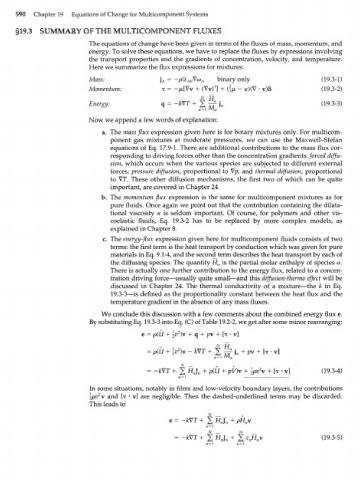Page 610 - Bird R.B. Transport phenomena
P. 610
590 Chapter 19 Equations of Change for Multicomponent Systems
§193 SUMMARY OF THE MULTICOMPONENT FLUXES
The equations of change have been given in terms of the fluxes of mass, momentum, and
energy. To solve these equations, we have to replace the fluxes by expressions involving
the transport properties and the gradients of concentration, velocity, and temperature.
Here we summarize the flux expressions for mixtures:
Mass: j = -pQ> V(x) binary only (19.3-1)
A AB A
+
Momentum: т = -/i[Vv + (Vv) ] + (f/x - *)(V • v)6 (19.3-2)
Energy: = _ T + £ ЙЧ« (19.3-3)
q f c V
a = \ 1Vi a
Now we append a few words of explanation:
a. The mass flux expression given here is for binary mixtures only. For multicom-
ponent gas mixtures at moderate pressures, we can use the Maxwell-Stefan
equations of Eq. 17.9-1. There are additional contributions to the mass flux cor-
responding to driving forces other than the concentration gradients: forced diffu-
sion, which occurs when the various species are subjected to different external
forces; pressure diffusion, proportional to Vp; and thermal diffusion, proportional
to VT. These other diffusion mechanisms, the first two of which can be quite
important, are covered in Chapter 24.
b. The momentum flux expression is the same for multicomponent mixtures as for
pure fluids. Once again we point out that the contribution containing the dilata-
tional viscosity к is seldom important. Of course, for polymers and other vis-
coelastic fluids, Eq. 19.3-2 has to be replaced by more complex models, as
explained in Chapter 8.
с The energy-flux expression given here for multicomponent fluids consists of two
terms: the first term is the heat transport by conduction which was given for pure
materials in Eq. 9.1-4, and the second_term describes the heat transport by each of
the diffusing species. The quantity H a is the partial molar enthalpy of species a.
There is actually one further contribution to the energy flux, related to a concen-
tration driving force—usually quite small—and this diffusion-thermo effect will be
discussed in Chapter 24. The thermal conductivity of a mixture—the k in Eq.
19.3-3—is defined as the proportionality constant between the heat flux and the
temperature gradient in the absence of any mass fluxes.
We conclude this discussion with a few comments about the combined energy flux e.
By substituting Eq. 19.3-3 into Eq. (C) of Table 19.2-2, we get after some minor rearranging:
2
e = p(U + \v )v + q + pv + [T • v]
2
= p(il + \v )v - kVT + 2 ТГ \a + Pv + [T • v]
2
= -kVT + 2 HJ a + рШ + pV)v + \pv v + [т • v] (19.3-4)
In some situations, notably in films and low-velocity boundary layers, the contributions
\pv v and [T • v] are negligible. Then the dashed-underlined terms may be discarded.
2
This leads to
= -kVT + 2 HJ + H v
e a P a
a = \
= -kVT + 2 HJ + f c H v (19.3-5)
a a a

